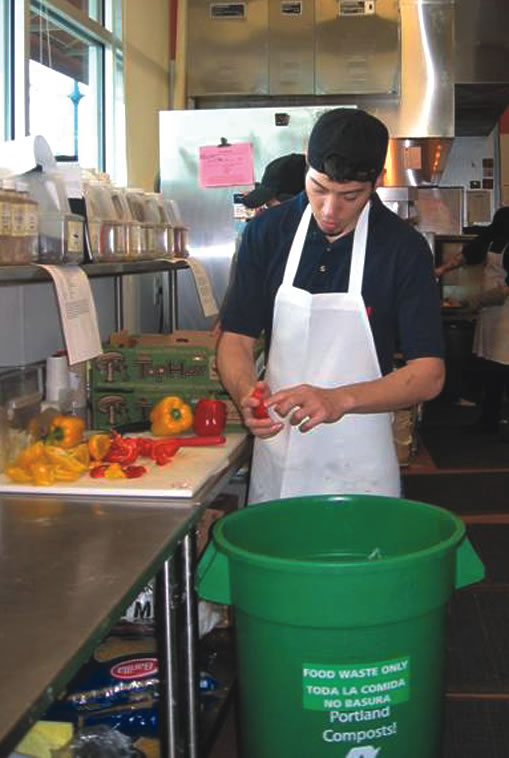The US EPA’S Food Recovery Challenge asks for a commitment to three food diversion actions: prevention, donation and composting. Program participants share their stories.
Ashley Zanolli
BioCycle March 2012, Vol. 53, No. 3, p. 48

ARIA is part of CityCenter Las Vegas, a MGM Resort International property. It is the largest LEED Gold building in the world, and recycled 1,800 tons of food scraps in 2011.
The Challenge raises awareness about the amount of food unnecessarily thrown in the trash and educates about how to divert this food to its best use. In 2010, Americans generated 250 million tons of municipal solid waste (MSW). Organic materials continue to be the largest component of MSW, a total of 56.3 percent. This includes paper and paperboard (29%), food scraps (13.9%) and yard trimmings (13.4%). The 13.9 percent translates into 34 million tons of food “waste” thrown away by U.S. homes and businesses — 97 percent of the total generated. No significant progress was made in diverting food waste from 2009. Amazingly, food waste is now the number one material sent to landfills and incinerators.
Unfortunately, much of what gets “wasted” is not waste at all, but is actually safe, wholesome food that could potentially feed millions of Americans. In 2010, over 14 percent of households in the U.S. were food insecure, i.e., households without access, at all times, to enough food for an active, healthy life for all household members. This translates into approximately 48.8 million people living in food-insecure households. One facet of Michelle Obama’s Let’s Move! campaign is dedicated to solving the problem of obesity including access to healthy foods. Donating food to those in need is just one of the ways to manage food more sustainably.
EPA’s Food Recovery Challenge asks participants to take three simple steps: Conduct an assessment of their current practices; Set a goal for reducing the amount of food waste being thrown out; and Commit to a more sustainable approach by tracking their efforts across three food diversion actions areas: prevention, donation and composting. EPA’s easy on-line measurement tool through WasteWise (http://www.epa.gov/osw/partnerships/wastewise/retrac.htm) charts participants’ progress and calculates their environmental footprint and greenhouse gas emission reductions.
Over the last year EPA has been working with the grocery industry, colleges and universities, and sports and entertainment venues among others to join the challenge. EPA targeted these sectors because they manage large volumes of food and provide valuable opportunities for outreach and education. To date, there are 77 FRC participants, some of whom are profiled below. (See “Stepping Up To The Food Recovery Plate,” March 2011, for profiles of other Challenge participants.)
MGM Resorts
MGM Resorts International, a global hospitality company, is striving to become more sustainable based on its philosophy of “Conserve Today, Protect Tomorrow.” All MGM Resorts properties in Las Vegas, Nevada, including Bellagio, MGM Grand, CityCenter, Mandalay Bay and Mirage, have implemented robust recycling and waste management programs that include the capture of food scraps. MGM Resorts collects surplus food and food waste from its 165 restaurants and 11 employee dining rooms throughout its 11 world-famous Las Vegas Strip resorts. To make this happen, MGM’s executive chefs, food and beverage departments, and green teams came together to design the food waste diversion program.
MGM collects only preconsumer food waste, including vegetables and fruits, bread, meat and dairy and requires that most restaurants, buffets, and employee dining rooms separate food waste inside their kitchens. To increase the volume captured, MGM also employs a 24-hour recycling staff to further sort food scraps and all mixed recyclables.
Food recovery quantities at the MGM Resorts Strip properties have rapidly increased from 3,350 tons in 2007 to more than 14,000 tons in 2011. Two distinct end users collect and process the waste. The first is RC Farms, a pig farm in North Las Vegas that feeds 3,000 pigs per day with food collected from the Strip. The farm does additional sorting of the food waste, pulling out nonedible items. RC Farms follows state requirements for animal feed, cooking the food waste to required temperatures prior to feeding the pigs. The second service provider is A1-Organics, a local composting facility. Both companies have implemented systems for food waste collection that removes material off the property as quickly as possible — an essential component of the program. Currently, about half of the food waste collected goes to animal feed, and half to composting.
In recognition of MGM Resorts’ outstanding leadership in food scrap recycling, the USEPA’s WasteWise Program awarded the company with a 2011 Gold Achievement Award for Food Recovery.
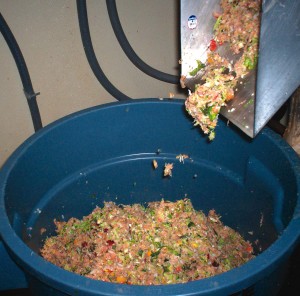
Middlebury College has had a food waste composting program since 1993. In the dining hall, plate waste is run through a pulper to remove excess water.
Middlebury College
Middlebury College in Middlebury, Vermont joined EPA’s Food Recovery Challenge in January 2012. The college was an early adopter of sustainable practices, initiating a composting program in 1993. Compacting roll-offs were placed outside each kitchen, and food waste was hauled 4.5 hours away to New York State for composting. Today, Middlebury College operates a composting site on campus. Approximately 7,000 meals are prepared daily and over 90 percent of food waste generated (approximately 370 tons in 2011) is diverted to produce 1,500 cubic yards of compost annually. Dining services is continually looking at generating less food waste by evaluating purchasing and preparation techniques.
A strong partnership between the dining services and facilities staff ensures a virtually contaminant free stream of food prep scraps, postconsumer food residuals, waxed cardboard, paper towels, napkins and waste paper. Plate waste is run through a pulper to remove excess water. A custom designed hook-lift truck collects the material from the kitchens daily, and takes it to the composting area, located approximately two miles from the center of campus on college lands mostly surrounded by fields and farmland. The food waste is mixed with horse manure and wood chips and composted in turned windrows. The finished product, affectionately known as “black gold,” is used on campus grounds, especially the athletic fields.
The compost operation is managed through the Office of Facilities Services and its Waste Management team consisting of five full-time staff members who oversee all waste-related activities on campus. All compost produced is utilized on campus. In 2010, Middlebury continued to expand food waste collection to its residence halls and offices. It avoided $101,475 in landfill fees by recycling 441.8 tons and composting 370 tons of food waste in 2011.
Middlebury College Dining Services is a member of the National Association of College and University Food Services. The college’s dining director, Matthew Biette, was instrumental in launching the Association’s Sustainability Awards this past August. The awards are designed to support the globally accepted triple bottom line philosophy, a method of evaluating operational performance by measuring financial success as well as environmental sustainability and social responsibility, and fit seamlessly with EPA’s Food Recovery Challenge. They will be presented for the first time in July 2012 at the Association’s annual conference being held in Boston, Massachusetts.
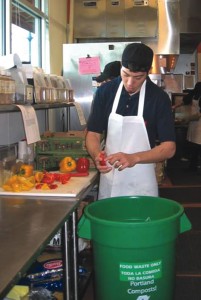
New Seasons Market staff spurred the company to create a more comprehensive composting program. In 2011, its stores diverted 2,410 tons of food waste.
New Seasons Market
New Seasons Market is a locally owned and operated grocery with 12 locations employing over 2,200 staff in the Portland Metro region of Oregon. The company has been actively involved in food waste prevention, donation and composting programs for a number of years. Each New Seasons Market store prioritizes food waste prevention. “Hunger and access to nutritious food is at epidemic proportions and the wasting of food taxes food production in ways that cannot be sustained,” Heather Schmidt, New Seasons Market’s Sustainability Manager. “We don’t want any food to go to waste and we also want to be environmentally responsible.”
Food that is still nutritious and safe, but can no longer be sold, is donated. Each store donates to up to four Oregon Food Bank-approved organizations on a weekly basis. Food and product are also donated to staff through the Blue-Slip Program, a system that allows staff to take home product with the approval of a manager. Last year, an estimated 1,040 tons of edible food were donated. In addition, New Seasons Market donates 10 percent of its after-tax profits back to the local community, with an emphasis on fighting hunger, protecting the environment and educating youth.
New Seasons Market began separating organics for composting in 2003. Four years later, the company stepped up its effort with the help of the new Portland Composts! program and company-wide Green Teams to support more comprehensive waste prevention and diversion. Its garbage was cut and organics diversion to composting increased by 109 percent. “It was obvious that people were on board and staff were excited about doing a better job, but we needed a coordinated, easy-to-use system to make prevention and diversion more successful,” explains Schmidt.
She worked with one store at a time using a phased approach that first targeted high impact departments with the greatest waste. Color-coded containers (green for compost, blue for recycling, and brown or black for garbage) were placed at strategic points of waste generation and signage and training materials were created internally to match both the waste materials and the company’s graphic style. In addition to creating a consistent system across all stores, Green Teams were key in providing the necessary leadership to coordinate a more robust program. Green Team Committees represent each department in the store and act as liaisons and support waste diversion within their department. In 2011, New Seasons Market diverted 2,410 tons of food waste to composting.
North Texas Food Bank
The North Texas Food Bank (NTFB) in Dallas receives donations of food that would otherwise be wasted from retail stores, manufacturers, distributors and other sources in the supply chain. The Food Bank makes donations available through its network of 300 Member Agencies and over 1,000 feeding and education programs in 13 North Texas counties, including food pantries, soup kitchens and shelters, after-school programs, senior citizen centers and other social service centers. Member Agencies receive food from the Food Bank and distribute it to North Texans in need through their pantry and on-site meal programs. The NTFB supplements these donations with over $4 million in purchases of nutritious staples, such as milk, eggs, tuna, beans and pasta as well as fresh produce.
Its new three-year strategy, ReThink Hunger, acknowledges that the issue of hunger has become larger and far more complex. With long-term unemployment, poverty, hunger and food insecurity rates at or near all-time highs, simply moving more food out the door cannot be the only solution. The ReThink Hunger initiative encompasses: Fifty percent more fresh produce and 100 percent increase in retail store food donations (more protein); Adding a second distribution center with 25,000 square feet of cold storage to support more produce and protein; and Establishing The Hunger Center of North Texas to learn more about the needs of people struggling with hunger and what works. This allows NTFB to more accurately measure the outcome of the Food Bank’s programs and identify new ways to address needs in the community.
In terms of produce that is no longer fit for human consumption, NTFB works with several pig farmers to take that material. It also partners with organizations that can use the compostable materials, such as Paul Quinn College, also in Dallas, which recently transformed its football field into a 2-acre urban farm (see sidebar in this issue’s Community Sustainability feature).
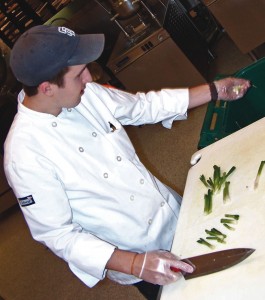
Kitchen staff at Petco Park in San Diego consider composting second nature. The stadium started a food waste diversion program in 2005 to save money on its disposal fees.
Petco Park
Petco Park, home of the San Diego Padres, has been composting food scraps since 2005. Like many other organizations, Petco Park began composting to save money — not in response to the “green” buzz around food composting. It pays for trash disposal by the ton, and the wet, heavy food contributed significantly to its hauling bill. Given that the stadium’s food waste is less expensive to haul to a composting facility than to the landfill, the ballpark initiated a collection program in its main kitchen. By the end of 2005, 60 tons of food waste were diverted and close to $6,000 in hauling costs were saved.
During the 2007 season, the contracted concession group, DNC Sportservice, expanded the program from the main kitchen to all food service areas throughout the ballpark. With assistance from Hines, the facility management company, as well as its waste hauler, Waste Management, the ballpark installed proper equipment to facilitate a successful expansion. Labels and instructions were put on compost bins to ensure employees knew how to dispose of excess food properly. Additionally, Petco Park initiated a program where designated staff check the green bins after every game to ensure that minimal contamination, such as plastic, is sent to The Greenery, the city of San Diego’s composting facility (see “Large-Scale Generators Succeed With Organics Diversion,” November 2011). By the end of 2007, DNC Sportservice diverted 92 tons, saving over $9,000 in hauling costs. Once the concession group saw the amount of surplus food, it changed purchasing practices, saving money and reducing the amount of waste generated.
Fast forward to 2012 and the kitchen staff now considers composting second nature. Everything, from the small scraps of food from the dishwashing stations to the bits that are rinsed out of the bins at the end of each night, is captured and diverted. Petco Park also donates edible food to the San Diego Rescue Mission, a local homeless shelter. In 2011, staff at Petco Park increased landfill diversion to 164 tons, and brought total savings since 2005 to over $75,000. In 2011, EPA recognized Petco Park for its outstanding work to reduce excess food from reaching landfills.
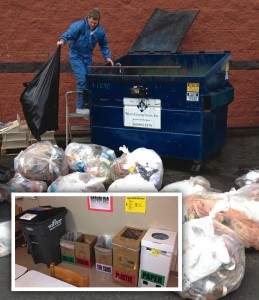
As part of the “cultural revolution” at SUPERVALU, associates and store directors are encouraged to “know their garbage.” Waste audits (top) are a starting point to see the potential for reuse and recovery. Recycling stations (below) are set up by individual stores and can be as simple as reusing boxes to capture materials (inset).
SUPERVALU
In 2007, two key members of SUPERVALU’s environmental and facilities team began an in-depth analysis of the waste stream from the company’s Albertsons grocery stores in Southern California. The analysis was part of a project focused on understanding the business value of recycling. Their work would kick off a chain of events that is now fundamentally redefining the entire company’s culture and accelerating its focus on waste reduction.
Historically, economic lifecycles have been linear systems where natural resources are used to make food and consumer goods and, once consumed, packaging and organic waste are dumped into landfills. At SUPERVALU, the company has come to understand that what it’s really throwing away is money, represented as embedded energy in a product’s creation and a lost opportunity to reuse or recycle the resources going to landfill.
A cultural revolution is underway within SUPERVALU. In 2010 and 2011, for the first time in the company’s history, recycling income was greater than landfill expenses. Stores across the country are participating in food bank donation programs, giving literally millions of meals to hungry people through food that would have otherwise gone to waste. In each region, the company is constantly looking for ways to divert food waste and organic material to secondary uses, including composting and animal feed.
SUPERVALU is encouraging associates and store directors to “know their garbage.” The company wants them to understand everything in the waste stream, because something is triggered when associates see their garbage during a waste audit — they begin to recognize the potential. Through these programs, SUPERVALU found that with operational changes such as requiring various departments in stores to source separate, and a commitment at the store-level, 90 percent or more of the “waste” from a typical grocery store can be reused, donated to feed people in need or recycled. What initially may begin as an annoying change in practices quickly becomes the “new normal” in how “wastes” are viewed and handled.
By changing buying practices, SUPERVALU is attempting to create a waste (resource) stream that is 100 percent reusable or recyclable. For example, the company is working with produce suppliers to package grapes in reusable crates, versus polystyrene, which is not a universally recycled material. Supporting a zero waste to landfill goal also has had profound effects in other areas, such as adopting zero waste policies for energy and water. In the final analysis, SUPERVALU believes that what we waste determines what we value. SUPERVALU believes in valuing everything and wasting nothing.
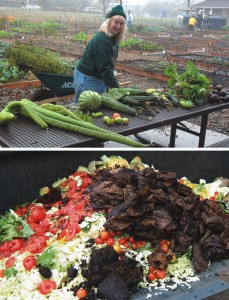
The University of Texas at Arlington incorporates an organic community garden (inset) and a composting site as part of its commitment to be a sustainable campus. Diverted food waste includes coffee grounds and filters, fruit peels, leftover salads and boiled eggshells (above).
University Of Texas At Arlington
The University of Texas (UT) Arlington incorporates an organic community garden and a composting site as part of its commitment to be a sustainable campus and promotes reuse and recycling. The community garden is a first-of-its-kind collaboration between UT Arlington and the city of Arlington. It has helped strengthen the university’s bonds with the surrounding community, while encouraging healthy, more sustainable food options. Since its inception in spring 2011, the garden has donated over 800 pounds of food to the Mission Arlington, a church in the city. The garden also incorporates rainwater-harvesting techniques to promote water conservation.
The community garden complements the UT Arlington composting program, which began in 2003 and is an outstanding learning tool and model for others considering similar programs. UT-Arlington is a 450-acre campus and has a student, faculty and staff population of more than 34,000 people. A large portion of its wastes are landscape debris, leaves and food generated from dining services. Food items that are collected and composted include coffee grounds and paper coffee filters, fruit peels and skins, leftover salads and boiled eggshells.
In 2006, UT Arlington received a $135,000 grant from the Texas Commission on Environmental Quality and the North Central Texas Council of Governments to purchase an in-vessel composting drum and equipment to improve efficiency and expansion of its recycling and composting programs. Due to challenges in operating the drum, it is not used for actual composting. Instead, kitchen waste and coffee grounds are weighed and mixed when they arrive, then added to the newest pile in layers roughly 2-inches thick and covered with 6- to 8-inches of dried leaves. The leaves are watered three to five times as thin layers are added. Once the pile reaches a height of 3-feet, it is mixed and moved with a skid-loader; water is added if needed. Piles are turned 3 to 4 more times as time and space permit.
The composting program is operated by the Grounds Department in the Office of Facilities Management. Finished compost is screened and recycled back into campus landscaping, the community garden and recreational fields. In 2010, 40,152 lbs of food waste, 19,743 lbs of coffee grounds, 27,800 lbs of leaves and, 12,000 lbs of grass were composted. In 2011, 61,566 lbs of food and landscape debris were composted.
Ashley Zanolli is a senior environmental engineer with organics management expertise in the EPA Region 10 Seattle office. She is leading the implementation of EPA’s Sustainable Food Management Initiative in Alaska, Idaho, Oregon and Washington and works nationally to help develop value-added tools for Food Recovery Challenge partners. If you are interested in joining the FRC, have a case study to share or have questions, please reach out to your regional EPA contact listed in the table. BioCycle thanks the following contributors to the article: Brad Tomm, MGM Resorts International, Heather Schmidt, New Seasons, Lauren Banta and Kim Smith, North Texas Food Bank, Pete Pearson, SUPERVALU, Alina Talbott, Hines Interests, LP (Petco Park), and Meghna Tare, University of Texas Arlington, as well as Christine Beiling (EPA Region 1) and Laura Moreno, (EPA Region 9).


